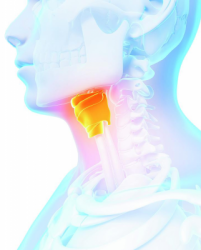

LARYNGECTOMY.NET
Most common reasons for consultation
Dysphagia or aphagia
Dysphagia is common after a laryngectomy.
- Stenosis of the neo-pharynx:
- Predisposing factors: post-operative radiotherapy, insertion of pectoralis major flap, insertion of muscle flap without skin paddle.
- Clinical: Slowly progressive onset, especially with solids, and the liquids as well
- Diagnosis: ENT consultation and nasofibroscopy or upper gastrointestinal series
- Degree of urgency: requires hospitalisation in case of aphagia
- Tumour recurrence: :
- Predisposing factors: continuing alcohol-tobacco intoxication
- Clinical: presence of pain, odynophagia, progressive onset, SAE
- Diagnosis: ENT consultation and nasofibroscopy, an injected cervical-thoracic CT-scan could be requested to save time
- Degree of urgency: depending on the severity of the dysphagia
- Radiation mucositis: :
- Predisposing factors: patient undergoing radiotherapy
- Clinical: erythematous rash and ulcerations of oral mucosa
- Treatment: sodium bicarbonate 14/1000 mouth wash, xylocaine oral gel, analgesics
Coughing while swallowing
- Leakage of phonatory prosthesis:
- Most common cause of coughing while swallowing
- Mechanism: animated film
- Diagnosis: ask the patient to swallow some mint syrup while looking into the tracheostomy orifice with light, cannula withdrawn. Visualisation of discharge that could come from within the phonatory prosthesis, or from the edge
- Treatment: Change of phonatory prosthesis in ENT consultation immediately
- Pharyngostoma:
- Essentially during early post-operative period, when the patient is still hospitalised
- Very rare in outpatient consultation
Dyspnoea
- WARNING: Inhalation of phonatory prosthesis:
- Clinical: sudden onset dyspnoea, appearing after coughing or after a meal, no phonatory prosthesis visible through tracheostoma orifice, the patient did not find the phonatory prosthesis
- Course of action: urgent referral to University Hospital, medical transfer depending on tolerance and O2 saturation
- Inhalation of foreign body:
- Clinical: sudden onset dyspnoea, patient not wearing tracheostoma protection
- Course of action: urgent referral to University Hospital, medical transfer depending on tolerance and saturation
- Inhalation of liquid: shower, batch, etc.
- Usual causes of dyspnoea
Appearance of pain
The pain due to the surgery do not persist.
A patient some time after the laryngectomy (1 month) and who is not undergoing radiation therapy should not have any pain.
Any recent onset pain is therefore suspicious and requires a control ENT consultation, initiation of analgesic treatment.
Bleeding of the tracheostomy orifice
- Simple bud:
- Very common
- Clinical: presence of skin and/or mucosa nodule in the tracheostomy orifice that bleeds on contact
- Course of action: in case of profuse bleeding, insertion of tracheotomy cannula with inflated balloon to prevent the inhalation of blood, refer to ENT consultation immediately
- Treatment: burn the bud by application of silver nitrate (swab), several sessions may be required depending on the size and the number of buds
- Tumour recurrence:
- Recurrence of cancer around the tracheostomy orifice responsible for bleeding
- Course of action: in case of active bleeding, insertion of tracheotomy cannula with inflated balloon to prevent the inhalation of blood, refer to ENT consultation immediately for biopsy
Cervical swelling
- Cervical lymphoedema:
- Common cause of neck swelling, sometimes mistaken for an adenopathy
- Clinical: median, broad, slightly indurated, non-fixed, non-painful cervical swelling
- Treatment: none
- Cervical adenopathy:
- Highly suspicious of recurrence
- Course of action: rapid ENT consultation for control and cytopuncture
Loss of phonatory prosthesis
- WARNING: Risk of inhalation of phonatory prosthesis:
- Clinical: sudden onset dyspnoea, appearing after coughing or after a meal, no phonatory prosthesis visible through tracheostoma orifice, the patient did not find the phonatory prosthesis
- Course of action: urgent referral to University Hospital, medical transfer depending on tolerance and saturation
- Loss of phonatory prosthesis
- Clinical: the patient recovered his/her phonetary prosthesis
- Course of action: refer the patient to ENT consultation immediately, because there are two risks: inhalation of saliva via the oesotracheal fistula, closure of oesotracheal fistula

